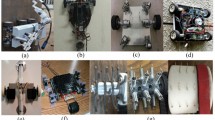Abstract
A new walking pattern classification method is proposed for a 5-link 7-DOF biped robot walking on an uneven floor. This method extracts the patterns in the current floor position of the stance foot and the transitioning floor conditions of the swing foot during locomotion. When a global path composed of stairs, obstacles, etc., and certain walking parameters, such as the speed of walking and the total walking time, are put into the system, the guidance controller unit determines the trajectory of the footsteps in terms of step patterns by using a genetic algorithm-based optimization technique while ensuring the biped’s stability criterion. A demonstration of the biped with different pattern classes was realized by a dynamic simulator.
Similar content being viewed by others
References
Hurmuzlu Y (1988) Dynamics of bipedal gait. Part I. Objective functions and the contact event of a planar five-link biped
Hurmuzlu Y (1993) Dynamics of bipedal gait. I: Objective functions and the contact event of a planar five-link biped. J Appl Mech 60(2):331–336
Shih CL (1997) Gait synthesis for a biped robot. Robotica 15:599–607
Kurematsu Y, Kitamura S, Kondo Y (1988) Trajectory planning and control of a biped locomotive robot: simulation and experiment. In: Robotics and manufacturing (recent trends in research, education, and applications). Proceedings of the second international symposium on robotics and manufacturing — research, education, and applications. American Society of Mechanical Engineers, vol. 2, pp 65–72
Zielinska T (1996) Coupled oscillators utilized as gait rhythm generators of two-legged walking machine. Biol Cybern 4(3):263–273
Kajita S, Tani K (1991) Study of dynamic biped locomotion on rugged terrain: derivation and application of the linear inverted pendulum mode. Proceedings of the IEEE International Conference on Robotics and Automation, 2:1405–1411
Zheng YF, Shen J (1990) Gait synthesis for the SD-2 biped robot to climb a sloping surface. IEEE Trans Robotics Autom 6(1): 86–96
Hirai K, Hirose M, Takenaka T (1998) The development of a Honda humanoid robot. Proceedings of the IEEE International Conference on Robotics and Automation
Kun AL, Miller WT (1999) Control of variable-speed gaits for a biped robot. IEEE Robotics Autom Mag
Zheng YF (1990) A neural gait synthesizer for autonomous biped robots. Proceedings of the IEEE International Workshop on Intelligent Robots and Systems: Towards a New Frontier of Applications, 2:601–608
Arakawa T, Fukuda T (1996) Natural motion trajectory generation of biped locomotion robot using genetic algorithm through energy optimization. IEEE International Conference on Systems, Man, and Cybernetics, 2:1495–1500
Cheng MY, Lin CS (1998) Genetic algorithm for control design of biped locomotion. J Robotic Syst 14(5):365–373
Hemami H, Farnsworth RL (1977) Postural and gait stability of a planar five-link biped by simulation. IEEE Trans Autom Control 22(6):452–458
Dasgupta A, Nakamura Y (1999) Making feasible walking motion of humanoid robots from human motion capture data. Proceedings of the IEEE International Conference on Robotics and Automation 2:1044–1049
Chevallereau C, Aoustin Y (2001) Optimal reference trajectories for walking and running of a biped robot. Robotica 19:557–569
Channon PH, Hopkins SH, Pham DT (1992) Derivation of optimal walking motions for a bipedal walking robot. Robotica 10(2): 165–172
Yuksel B (2008) Towards the enhancement of biped locomotion and control. PhD Dissertation, Middle East Technical University
Author information
Authors and Affiliations
Corresponding author
Additional information
This work was presented in part and awarded Best Paper Award at the 16th International Symposium on Artificial Life and Robotics, Oita, Japan, January 27–29, 2011
About this article
Cite this article
Yuksel, B., Leblebicioğlu, K. Toward the enhancement of biped locomotion and control techniques: walking pattern classification. Artif Life Robotics 16, 208–213 (2011). https://doi.org/10.1007/s10015-011-0919-7
Received:
Accepted:
Published:
Issue Date:
DOI: https://doi.org/10.1007/s10015-011-0919-7




